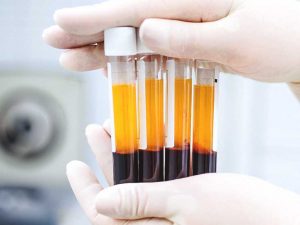What Is Platelet-Rich Plasma Therapy?
 Platelet-rich plasma (PRP) is a form of regenerative medicine that can be injected into injury sites to encourage the body’s natural healing process. Plasma is one of the main components of your blood, along with platelets, and red and white blood cells. Once separated and extracted from the sample, PRP contains concentrated amounts of platelets and growth factors. These growth factors help blood to clot and encourage cell growth and regeneration.
Platelet-rich plasma (PRP) is a form of regenerative medicine that can be injected into injury sites to encourage the body’s natural healing process. Plasma is one of the main components of your blood, along with platelets, and red and white blood cells. Once separated and extracted from the sample, PRP contains concentrated amounts of platelets and growth factors. These growth factors help blood to clot and encourage cell growth and regeneration.
The team of experts at the Specialized Rehabilitation Physicians Group offers cutting-edge PRP therapy to our patients who are suffering from a range of musculoskeletal and degenerative conditions. It serves as an excellent alternative to surgical procedures, at a fraction of the cost, reduced risk, and is minimally invasive. This article aims to answer common questions about PRP therapy as well as provide information about the applications where it is most useful.
How PRP Can Help
PRP has a wide range of medical uses but has seen the greatest results when treating musculoskeletal conditions and injuries.
Tendon injuries: Tendons are known to be difficult to repair, however, doctors have used PRP therapy to treat chronic tendon injuries like tennis elbow and Achilles tendonitis. This 2016 study highlights how PRP encourages cellular proliferation, expression of anabolic proteins, and reduces inflammation in the area.
Acute injuries: Sprains, strains, and muscle tears are some of the most common sports injuries.
Osteoarthritis: PRP has shown to be both safe and effective at helping to treat patients with knee osteoarthritis. According to the NIH, PRP growth factors offer incredible anti-inflammatory properties while also adding coagulating factors and a matrix for cartilage to rebuild upon.
Platalet Rich Plasma Therapy by Dr. Javier Placer
What To Expect From A PRP Session?
The process is nearly painless and is administered using precision-guided equipment in the hands of our highly trained physicians. Make an effort to wear clothing that allows easy access to the target area. You should speak to your specialist ahead of time if you think you will require additional numbing or sedatives. The majority of our patients are perfectly fine without it.
What is the PRP Injection Process?
Here’s what to expect from a typical PRP injection process:
- A blood sample is extracted via a needle and is drawn into a special syringe.
- A centrifuge, which spins at a very high speed, allows the sample to separate into its respective components.
- The plasma, now rich with platelets, is extracted and separated from the rest of the sample, ready for injection into the affected area.
- PRP specialists use ultrasound guidance tools to pinpoint specific areas for injection, enabling maximum precision and effectiveness. Your doctor will then inject the PRP into the affected area
How Much Does PRP Cost?
The cost of PRP varies depending on a range of factors. The number of sessions you require, the size of the area being treated, and your own personal goals or desired outcome all influence what your PRP plan will look like, and affect the cost as such!
During an initial assessment, our specialists will diagnose the full scope of your condition! Based on the outcome, you will be provided with a plan that is unique to your needs and matches your recovery goals.

What are the Potential Side Effects of PRP?
PRP has been determined to be both safe and effective, primarily due to the fact that it is an autologous procedure. This means it contains materials that naturally occur in the body and therefore, is not at risk of being rejected.
- All injections have an inherent risk of causing bleeding, infection, or injuring a nerve, these are not unique to PRP treatment. We mitigate most of this risk using expertly trained techniques and years of experience.
- If you have any history of cancer or blood disorders, you should discuss treatment with your doctor.
- Some patients will experience brief (1-3 days) discomfort and inflammation due to the healing reaction that is taking place.
- You should always disclose all medical information during the consultation so the doctor can make the best, most informed decisions regarding your therapy!
What is the Recovery Time for PRP Injections?
After each PRP session, your doctor will recommend a post-injection rehabilitation to optimize your body’s response to the treatment. You may be asked to let the affected area rest, modify activity, and gradually ease into normal activity over a couple of weeks.
PRP is not a quick-fix procedure, instead, it is much more of a long game, comprehensive regenerative procedure. The goal is to regenerate the injured tissue at its source. By providing regenerative therapy, tissue may heal in a more comprehensive way and restore musculoskeletal integrity to the affected area, preventing re-injury and relieve your pain. Regeneration occurs gradually over a period of months, compounding with each recurring session.
Platelet-Rich Plasma Therapy Available In Clermont, Florida
If you have suffered a muscular, tendon, or joint injury, PRP therapy could be an excellent option for you! The best way to know for sure is to speak with one of the professionals at the Specialized Rehabilitation Physicians Group. We can expertly diagnose your condition and provide PRP therapy to help relieve your pain and restore function to the target area. Let us help you live a healthy, happy, and active life! Call our offices to speak with a representative from our team or schedule a consultation online today!
[/fusion_text][/fusion_builder_column][/fusion_builder_row][/fusion_builder_container]

